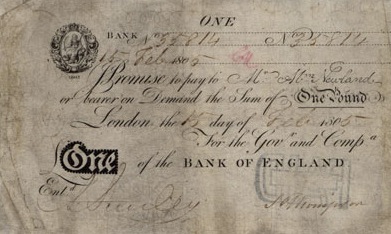The Bank of England issued the first-ever £1 note on February 26, 1797. This event, spurred by the extraordinary circumstances of the era, marked a significant moment for British currency and financial practices.
The late 18th century, amidst the turmoil of the French Revolutionary Wars, saw the British economy under immense strain, leading to a critical shortage of gold bullion. To address this crisis, the Bank of England, in a display of remarkable ingenuity, began issuing banknotes for smaller denominations, including the groundbreaking £1 note.
These early monetary notes were far from the standardized printed money we know today. Each £1 note was handwritten. Unlike any money we use today, the single-sided notes have the single-sided payee’s name, the date, and the issuing cashier’s signature. Due to the shortage, these notes could not be exchanged for gold between 1797 and 1821, a suspension that came to be known as the “Restriction Period.” After the Napoleonic Wars, the gold standard was reinstated, allowing notes to be exchanged for their equivalent in gold. However, the £1 note ceased issuance in 1821, replaced by gold sovereigns.
Legacy of the £1 Note
Although its initial lifespan was brief, the £1 note left an enduring mark on British monetary history. It proved the power of paper money’s flexibility and resilience during a critical crisis. Over the centuries, the note underwent several different redesigns and reintroductions, including during World Wars I and II, as Britain faced new challenges, always standing strong.
Although the original £1 note might seem modest by today’s standards, its issuance was nothing short of revolutionary. It symbolized innovation under pressure and laid the groundwork for the currency systems we use today, inspiring future generations to think creatively in times of crisis.

